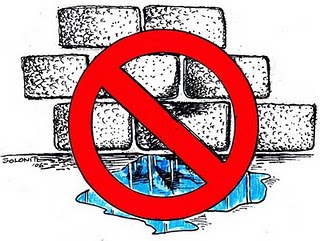Tips For Damp Basements
Do you have a damp basement?
Recently I have been bidding on a lot basement remodels. Many of these basements have had issues with water or were damp. Before you remodel a basement you need to make sure you have resolved any damp or mold issues. Many times a damp basement has mold.
Eliminate Mold
The key to mold control is moisture control. It is important to dry water damaged areas and items within 24-48 hours to prevent mold growth.
If mold is a problem in your home, clean up the mold and get rid of the excess water or moisture.
Damp basements can be a result of many things from a high water table, a plumbing leak, water leaking through the foundations walls or high humidity. All of these factors lead to mold, mildew growth.
Damp conditions and water leaks can lead to wood rot and even worse, structural damage, as well as health problems.
Sump Pumps
High water table is best corrected with sump pumps and perimeter drains.
The majority of issues I have seen are a direct result of the water migrating through the foundation wall. This usually is a result of improper landscape draining, lack of gutters or not directing gutter run-off away from the foundation.,
Many remodeled basement walls will often develop a damp and musty smell [mold] because the concrete wall develops condensation on the cold concrete walls and floors during humid months.
Prior to remodeling your basement you need to eliminate the source of water or dampness. Corrective actions can be relatively easily but sometimes, depending on the severity of the problem, they can be difficult and expensive.
10 Tips for Damp Basements
1. Check for and repair all plumbing leaks.
2. Seal any cracks in foundation walls, windows and doors
3. Ensure that your dryer is vented to the outside. Check for holes in the hose and clean hose and vent yearly.
4. Basement bathroom showers should have vents to remove shower steam and moisture.
5. Dirt floors should be covered with a vapor barrier and preferably concrete.
6. Install gutters and ensure that the downspout directs water away from the foundations. Drain pipe extensions on the ground are helpful. Clean gutters often.
7. Re-grade the ground around the house so it slopes down and away from the foundation. Remove plantings that prevent this.
8. Install a sump pump if high water table. Make sure it is working properly.
9. During hot humid months, using a dehumidifier in the basement can reduce condensation on the walls.
10. Scrub mold off hard surfaces with detergent and water, and dry completely. Absorbent or porous materials, such as ceiling tiles and carpet, may have to be thrown away if they become moldy. Mold can grow on or fill in the empty spaces and crevices of porous materials, so the mold may be difficult or impossible to remove completely. Spray a bleach solution on these areas. Ventilate as you do this.
Subscribe here to receive updates via email











